| |

Traditions, folklore, history and more. If it's Irish, it's here. Or will be!
"People will not look forward to posterity who never look backward to their ancestors."
-Edmund Burke




Quotes
Library: Books, Movies, Music
Prints & Photos
Poetry
Jokes


Shops Ireland
Bunús na Gaeilge
(Basic Irish)
Circle of Prayer
Blessings
Did You Know?
Himself/Herself
Write to Us
Readers Write..
Links/Link to Us
Advertise with us
Awards & Testimonials
Submissions Guide


|
|
|
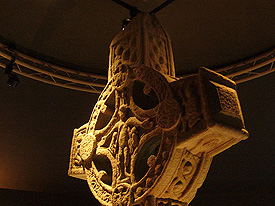 St. Kieran of Clonmacnoise St. Kieran of Clonmacnoise
compiled by Bridget Haggerty
St. Kieran or Ciarán of Clonmacnoise, also known as St. Kieran the Younger, was born around 512 AD in Connacht, a town located in the northern part of Co. Roscommon. The son of Beoit, a carpenter and chariot-builder, Kieran inherited a love of learning from his mother’s side of the family, as his maternal grandfather had been a bard, poet, and historian.
Baptized by deacon Justus (“the righteous one”), who also served as his first tutor, the boy Kieran worked as a cattle herder. Even this early in his life, stories testifying to Kieran’s holiness are told. Some later believed that his work as a herdsman foreshadowed the care he would offer the many who sought his wisdom.
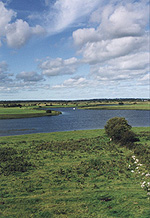 Kieran continued his education at the monastery of Clonard, which was led by St. Finnian. Yet another story, that of the “Dun-Cow of Kieran,” is associated with his move to this abbey. What is quite certain is that Kieran quickly gained the reputation of being the most learned monk at Clonard, and was asked to serve as tutor to the daughter of the King of Cuala, even as he continued his own studies. His friend and fellow student, Columcille of Iona, testified to Kieran’s brilliance by saying, “He was a lamp, blazing with the light of wisdom.” Besides being renowned for his brilliance, Kieran also had a great capacity for friendship with other leaders of the early Irish church. In addition to Justus, Columcille, and Finnian, Kieran counted Enda of the Aran Islands as his mentor, and both Senan of Scattery Island and Kevin of Glendalough as friends and colleagues. Kieran’s years of residence at Clonard were also marked by miraculous events that benefited the entire monastery. Kieran continued his education at the monastery of Clonard, which was led by St. Finnian. Yet another story, that of the “Dun-Cow of Kieran,” is associated with his move to this abbey. What is quite certain is that Kieran quickly gained the reputation of being the most learned monk at Clonard, and was asked to serve as tutor to the daughter of the King of Cuala, even as he continued his own studies. His friend and fellow student, Columcille of Iona, testified to Kieran’s brilliance by saying, “He was a lamp, blazing with the light of wisdom.” Besides being renowned for his brilliance, Kieran also had a great capacity for friendship with other leaders of the early Irish church. In addition to Justus, Columcille, and Finnian, Kieran counted Enda of the Aran Islands as his mentor, and both Senan of Scattery Island and Kevin of Glendalough as friends and colleagues. Kieran’s years of residence at Clonard were also marked by miraculous events that benefited the entire monastery.
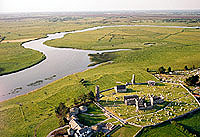 After completing his studies under Finnian, Kieran left Clonard and moved to the monastery of Inishmore in the Aran Isles, which was directed by St. Enda. While a member of this monastic community, Kieran was blessed with the vision of a great tree, which anticipated his own foundation of a renowned monastery. From Inishmore, Kieran went to visit his religious brothers at Isel in central Ireland. His stay here was brief, as the other monks envied his fame as a scholar, and resented what they considered his excessive charity to the poor. Asked to leave Isel, Kieran was led by a stag to Inis Aingin, or Hare Island. While he lived here for 3 years and 3 months, brothers from all over Ireland came to study under Kieran, and more miracles attested to his holiness. After completing his studies under Finnian, Kieran left Clonard and moved to the monastery of Inishmore in the Aran Isles, which was directed by St. Enda. While a member of this monastic community, Kieran was blessed with the vision of a great tree, which anticipated his own foundation of a renowned monastery. From Inishmore, Kieran went to visit his religious brothers at Isel in central Ireland. His stay here was brief, as the other monks envied his fame as a scholar, and resented what they considered his excessive charity to the poor. Asked to leave Isel, Kieran was led by a stag to Inis Aingin, or Hare Island. While he lived here for 3 years and 3 months, brothers from all over Ireland came to study under Kieran, and more miracles attested to his holiness.
 Kieran departed Hare Island with eight monastic brothers, and eventually settled at a location in the center of Ireland, on the east bank of the River Shannon. Here, in the year 544, he founded the great monastery of Clonmacnoise. Students by the thousands came to study there, not only from Ireland, but also from England and France. Clonmacnoise became Ireland’s center of study, art, and literature. To this day, tourists and pilgrims visit the site of Kieran’s monastery to see some of the finest monastic ruins and high crosses in all of Ireland. Kieran departed Hare Island with eight monastic brothers, and eventually settled at a location in the center of Ireland, on the east bank of the River Shannon. Here, in the year 544, he founded the great monastery of Clonmacnoise. Students by the thousands came to study there, not only from Ireland, but also from England and France. Clonmacnoise became Ireland’s center of study, art, and literature. To this day, tourists and pilgrims visit the site of Kieran’s monastery to see some of the finest monastic ruins and high crosses in all of Ireland.
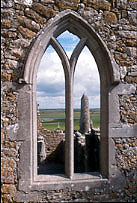 A mere 7 months after establishing Clonmacnoise, Kieran died, perhaps of the plague. Because of his prominence in the early Irish church, St. Kieran is known as one of the “Twelve Apostles of Ireland.” The Feast of St. Kieran is celebrated on September 9th. A mere 7 months after establishing Clonmacnoise, Kieran died, perhaps of the plague. Because of his prominence in the early Irish church, St. Kieran is known as one of the “Twelve Apostles of Ireland.” The Feast of St. Kieran is celebrated on September 9th.
Stories & Legends of St. Kieran
Kieran & A Fortunate Fox
One day as Kieran was watching the cattle some distance from the home of deacon Justus, Kieran realized he was able to hear his tutor’s instruction as closely as if he were in Justus’ house. On another occasion, while Kieran was out in the cattle pasture, a fox emerged from the forest and approached him. He treated the animal gently, so that it returned quite often. Kieran asked the fox to do him the favor of carrying his text of the Psalms back and forth between him and Justus. One day, however, the fox was overcome by hunger, and began to eat the leather straps that covered the book. While the fox was eating, a hunting party with a pack of hounds attacked him. The dogs were relentless in their pursuit, and the fox could not find shelter in any place except the cowl of Kieran’s robe. God was thus glorified twice – by the book being saved from the fox, and by the fox being saved from the hounds.
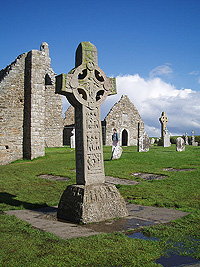 The Dun-Cow of Kieran The Dun-Cow of Kieran
When it was time for Kieran to leave home for the monastery of Clonard, he asked his parents for a cow to take with him as a contribution to the community. His mother refused this request, so Kieran blessed a cow of the herd, and the cow followed him to Clonard, accompanied by her calf. Not wishing to take both the cow and the calf, Kieran used his staff to draw a line on the ground between the animals. After that, neither the cow nor the calf would cross this line, and the calf returned home. The milk provided by Kieran’s cow was reputed to amply supply all in the monastery, as well as their guests.
Kieran Helps in a Time of Famine
During a time of famine, when it was Kieran’s turn to carry a sack of oats to the mill in order to provide a little food for the monks, he prayed that the oats would become fine wheat. While Kieran was singing the Psalms with pure heart and mind, the single sack of oats was miraculously transformed into four sacks of the best wheat. Kieran returned home and baked bread with this wheat, which the older monks said was the best they had ever tasted. These loaves not only satisfied their hunger, they were said to heal every sick person in the monastery who ate them.
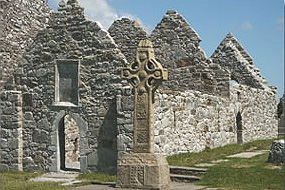 The Vision of the Great Tree The Vision of the Great Tree
While in the Aran Islands with St. Enda, both monks saw the same vision of a great and fruitful tree growing on the banks of a stream in central Ireland. This tree sheltered the entire island, its fruit crossed the sea surrounding Ireland, and birds came to carry off some of that fruit to the rest of the world. Enda interpreted this vision for his friend by saying, "The great tree is you, Kieran, for you are great in the eyes of God and all people. All of Ireland will be sheltered by the grace in you, and many will be nourished by your fasting and prayers. Go to the center of Ireland, and found your church on the banks of a stream."
A Cow Comes to Kieran’s Aid
A careless monk dropped Kieran’s text of the Gospels into the lake surrounding Hare Island, where it remained underwater for a long time. On a summer day when the cattle went into the lake, the strap of Kieran’s book stuck to the foot of one of the cows. When the book was retrieved, it was dry, with not a letter blurred or a page destroyed.
See More of Clonmacnoise
For a Virtual Tour of Clonmacnois Abbey, please click Clonmacnoise.
To visit a website with more photos and history of Clonmacnoise, please click Lawencetown.
Photo Credits:
Banks pf the Shannon
Global Geographia
Monastery from the air
Monastic Ireland
Clonmacnoise Monastery
High Cross at clonmacnoise
Turas Outdoor Adventures
South Cross at the Clonmacnoise Heritage Centre
Laurenz
Arched Window
Monastic Ireland
Clonmacnoise high cross and monastery walls
Content Sources:
St. Kieran Catholic Church Chicago Heights, IL
Aer Lingus Public Relations & Publicity Department - The Story of an Airline’s Saints
Delaney, John J. Dictionary of Saints (Doubleday & Company,
Garden City, NY, 1980)
Sellner, Edward C. Wisdom of the Celtic Saints Ave Maria Press,
Notre Dame, IN, 1993.
Wallace, Martin A Little Book of Celtic Saints (Belfast,
The Appletree Press, Ltd., 1995)
|
|
Fri, Sep 27, 2024
 The Galway Hooker The Galway Hooker
This unique vessel, with its distinctive curved lines and bright red sails, originated in the village of Claddagh. During the 19th century, hookers supported a significant fishing industry and also carried goods, livestock and fuel. Seán Rainey is remembered for building the last of the original boats, the Truelight, for Martin Oliver who was to become the last king of the Claddagh; as king, he was entitled to white sails on his boat. Since the mid seventies, many of the old sailing craft which were on the verge of extinction have been lovingly restored and new ones have been built. During the summer months they can be seen at festivals such a Cruinniú na mBád - the Gathering of the Boats - in Kinvara.
Click for More Culture Corner.
Illustrated with designs from the Book of Kells and other Celtic and Irish designs, the prayers reflect a profound view of nature and life. I strongly recommend this to pastors or lay people with any interest in Celtic culture. Edited from an Amazon review
Click here for Celtic Prayers.
|
St. Kevin's Feast Day is June 3rd. He is the patron saint of Dublin and Glendalough. This anachron shows Kevin standing in the lake, holding an egg that a black bird has left in his hand. An otter offers him salmon and apples grow on a willow tree. Other animals featured in legends of Kevin are also depicted.
Click here for St. Kevin.
|
|
|
|
|




 The Galway Hooker
The Galway Hooker